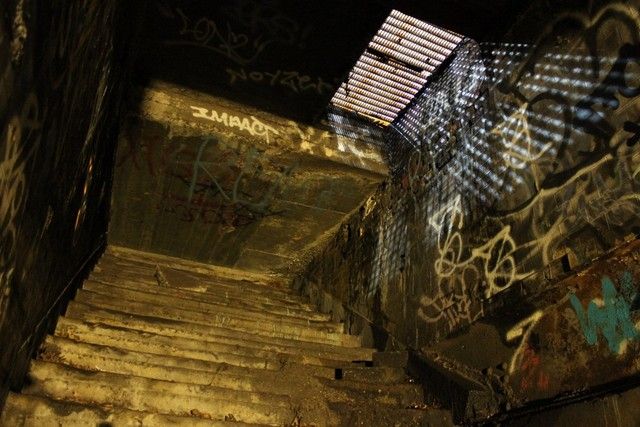
By Kaylee DeFreitas
I have always been fascinated by the subway tunnels that stretch beneath the city, funneling their way through the Manhattan schist and shuttling millions daily. With this fascination for the subway system also comes an interest in the stations lost to the past; those whose only purpose now is as a canvas for graffiti artists or a place for urban explorers to cross off their lists. I was aware of closed stations like the famed City Hall, whose Guastavino tiling and light fixtures remind one of a time when travel was treated with a heightened glamor. Despite this knowledge, I was unaware of a decommissioned station lying just between West 86th and 96th Streets; the long-gone 91st Street station.
The station is itself a remnant of the beginnings of New York City’s subway system. Built for the first subway line in NYC by the Interborough Rapid Transit Company (IRT), it began operating on October 27, 1904. The 91st Street station was one of 28 stops that existed on this original line, which ran along what are the 1, 2, 3 lines today.

Looking back at archival images of this station from 1957, I was able to see what lies beneath all the graffiti and years of decay. The station was adorned with the now iconic mosaics and tiling done for the IRT by Heins & LaFarge. “Both Parsons [constructor of the IRT line] and Heins & LaFarge believed that subway stations should be beautiful, but not have ornament just for ornament’s sake,” New York Transit Museum Curator Jodi Shapiro says. Shapiro states that while the 91st Street station was not unique among the original 28 stations, it still featured the repeating mosaic and design motifs that connect many of the IRT stations; such as egg and dart ornamentation and terracotta name plates. Framing these name plates on either side are mosaic columns. This design, according to Shapiro, are referred to as tapestries, and can be found within other original IRT stations in operation today.

The 91st Street station platform length is much shorter than that of modern-day platforms. The reason being that in 1904, when the IRT line began operation, local trains were only three to five cars long. Early in the line’s operation, the city deduced that these small trains and platforms would not be enough. “As soon as the system opened in 1904, it was running beyond capacity, it was jammed,” says John Morris, author of “Subway: The Curiosities, Secrets, and Unofficial History of the New York City Transit System.” This station did have its platform lengthened by a few tens of feet in either direction in 1910 to accommodate longer trains, but no further expansion was made; a factor that would lead to the station’s eventual demise. By the 40s, the 96th and 86th Street platforms were slowly closing the gap that once made the 91st Street station viable. The 96th Street platform expansion down to nearby 94th Street in the late 50s was the nail in the coffin; on February 2, 1959 the train stopped for the final time at the 91st Street station.

Now shuttered for over 50 years, the ghost platform still exists, frozen in time and camouflaged with graffiti. It is the latter that makes you have to look so closely for it as you pass it between the 86th and 96th Street stations. The graffiti affects your depth perception, making the station look like one long wall. It isn’t until you look purposefully that you begin to see the platform and beams take shape. Even above ground you will have to look closely to spot remnants of the station. “If you look really carefully on the North West corner, you can see the seams in the concrete [and] you can make out where the stairway was,” says Morris.
The draw of this station goes beyond that of the average curious straphanger or history enthusiast. If one googles 91st Street station, a slew of YouTube videos pop up of urban explorers rushing through the caverns of the MTA, dodging passing trains along the way, to make it to the decommissioned platform. Even author Andre Aciman’s interest was piqued by this very station, an experience he wrote about in a 1999 article for The New York Times. He described the endeavor as follows; “Wandering through this modern underworld, I tried to think of the great poets and the caves of Lascaux… but all I could focus on as I negotiated my way through a thick mantle of soot was dirt, rats and a faint queasiness.” From his description, it seems this was certainly not the revelatory adventure he was hoping for.
From current images and YouTube videos to Aciman’s account of the station, one question may settle on the mind: why? Why are people so drawn to decommissioned, dilapidated subway stations? Why do people careen their heads to get a glimpse of them passing by? Why do people risk their lives to explore these places lying just beneath our feet, even when they are falling apart? Perhaps it’s a way to feel closer to history; to be able to reach out and touch something, making your mark on the past and leaving it for the future. “I think it’s a combination of innate human curiosity about things from the past and particularly things that are underground and hidden,” says Morris.
Artifacts like this remind us all to take in the world around us and marvel in the everyday wonders, whether they be man-made or natural. While not as beautiful as it once was, the 91st Street station still holds some beauty to those who appreciate the history of the city and the tunnels below. “Transit history is also New York’s history; the city as we know it today would not exist without its transportation system,” says curator Shapiro. Next time you’re passing between the 86th and 96th Street stations, make sure to look out the window to try and spot the ghost station, the lights still illuminating the platform as it falls to the throes of time. And make sure to look closely, because if you don’t you just might miss it.

Subscribe to West Side Rag’s FREE email newsletter here.









thanks for writing about this station! A glimpse of old New York is visible out the window of the 1 train. If the Transit Museum resumes tours of the City Hall station (abandoned in 1945), I highly recommend that too.
The tours of the City Hall station have resumed — I did the tour last month. I believe that it helps to be a Transit Museum member to get a ticket — they sell out quickly.
Great research and article. Thanks!
I love these kind of stories! It’s fascinating to think of all the ways the city has changed…and will continue to change. Thanks for a wonderfully detailed history.
I will peer out the window on my next trip on the 1 line to see if I can spot the ghost station.
You can see it! I fascinated my kids with it one day, well, sort of fascinated them… plus it’s a really nice antidote to those days when the train seems like it’s crawling between stations 🙂
You must be aware that “lost” subways and their stations is practically a cottage industry – and not just for New Yorkers. One of the best known websites is: https://www.nycsubway.org/wiki/Abandoned_and_Disused_Stations
There are plenty of other websites, including Wikipedia.
Although not “lost” I have a fascination with closed entrances. I still recall the closed staircase that used to be in front of Tower Records on the north-west corner of 66th Street and Broadway. There’s also the closed staircase on the west side of Central Park West for the 59th Street station – more interesting because they occasionally re-open it, when the current grand (but steep) staircase needs repairs.
Bob, do you know anything about what appear to be two blocked doors in the north retaining wall of the 86th St. transverse, east of the police station? (Another intriguing remnant: a chunk of the old Central Park reservoir wall visible from the transverse just adjacent to the station.) Sometimes the city that was seems more interesting than the city that is.
Thank you for this article. I noticed the station when I was in high school and I would switch from the 2 to the 1 (or 9!) and I’d see it as the train was heading downtown.
I long suspected that I was not the only one fascinated by this “ghost” station. Thank you for an informative and thought provoking article.
Great Article ‼️
Whenever I see the abandoned West 91st Street station with its graffiti, I think it could be, or was a Twilight Zone episode. Didn’t find the answer on Google…
In her novel, The Young Unicorns, Madeleine L’Engle (who lived on 105th and WEA) used this ghost station as the setting for part of the story.
I moved to New York City from Skokie, Illinois, in 1975 to go to grad school at NYU, and was lucky enough to find a 3 BR apartment on one of “those scary blocks above 86th Street,” namely West 89th Street between CPW and Columbus, which I shared with 3 roommates who split the then-$600 monthly rent (and which I am now STILL living in with my adopted son, though for a bit more than $600/month!).
I remember seeing this ghost station at 91st Street while traveling uptown and passing my usual 86th Street stop on the way to wherever-it-was farther uptown… maybe to the103rd Street stop and Equity Library Theatre, for whom I designed four sets (She Loves Me, Up In Central Park, Plain and Fancy, and Allegro – for which composer Richard Rodgers signed my poster!)… very exciting for this relative New York newbie.
But 91st Street always fascinated – and frustrated – me. Every time I passed it by I wondered: why did it close? Why couldn’t I have a subway entrance just 2 blocks north of my street instead of 5 blocks north or 3 blocks south? (I admit: I was being selfish… and lazy). How did people get in there to graffiti it? So it’s interesting to understand that the closing was due to the shortness of the station. And that very few stations in Manhattan are only between 4 or 5 blocks apart. 8 blocks apart, 10 blocks apart, that’s reasonable… so I got over it.
It’s such fun to look back on it all… 😉
Fascinating, thank you.
That old photo from the street is right in front of Barzini’s. I once read that the buildings on the other side of the street might have been connected to this subway, but are now sealed off.
Correction: the original IRT line ran along the present-day 1, 2 & 3 lines, then turned east along the current 42nd Street Shuttle tracks, and then south along the present-day 4, 5 & 6 lines to the now-abandoned City Hall station. The original Times Square station was at the western end of the current shuttle platform, and served only tracks 1 & 4 (it was a local station). The space is still there between current shuttle tracks 1 & 4 for the abandoned express tracks 2 & 3. And the track connections still exist to the main lines – from track 4 to the uptown #1 at Times Square, and from track 1 to the southbound #6 at Grand Central (these connections are in plain sight). That’s how they move shuttle trains off 42nd Street for maintenance.
I have always wondered why the shuttle platforms are numbered platform 1, platform 2 and platform 4. Couldn’t understand why there wasn’t a platform 3 (we’ve joked many times that someone in charge apparently didn’t know how to count!). Now it makes some sense. Thank you!
Yes, I was about to write this comment, so thanks. Wouldn’t it still be nice to ride from the upper westside to the lower eastside without having to change trains!
I remember it well. But exploring such dangerous places should not be encouraged at all. At least, now, it provides a lounging space for all the ghosts of Manhattan. If you don’t think you have any, look up at the corners of your ceilings…
Facing backwards on the seat and peering out into the dark subway tunnel as the ghost station sped by was a major activity back in the day for those of us who grew up on the UWS!!
And when they had the big window in the very front of the first car we kids used to plaster our faces up against to look forward as the subway sped through the tunnels! That was a great way to see the 91st st station.
From 1952 to 1955 my high school subway pass allowed me to access the subway at the 91st Street Subway Station. At the time, the station nor the system didn’t have any of the graffiti or any of the other ills that befell the subway in future times. It was public transportation at its best and if you were paying, a token cost fifteen cents.
From a time where beauty and artistry were the typical standards of construction.
Take a peek at other subway station “ghosties” while you’re at it…18th Street and Worth Street on the Lexington Avenue Local (“6”) and Myrtle Avenue (Manhattan-bound on the “B” or “Q”), right after DeKalb Avenue. Also viewable is the abandoned, decommissioned, de-tiled Bergen Street lower level, when the “F” runs express between Jay Street and 7th Avenue. Plus, as many already know, ride the “6” to Brooklyn Bridge, stay on and catch a glimpse of the original City Hall as the train screeches thru the tunnel on its back-uptown turnaround. Best time: rush-hours, when there’s a conga line of waiting trains.
I thought the station was made to accommodate the Astor Court, Apartments.
I remember the 91st Street station well. I lived on West 95th Street and I found the. 91st Street stop very useful. It disappeared the year I graduated college and for years I kept feeling a station was missing whenever I caught the Broadway line. I still every so often think of it and regret its absence..
Last time I glimpsed, there were still a few folks waiting for a train that they think has to be coming any minute.
You’d think that after 3 or 4 trains pass by without stopping they might take a hint.
For as long as I’ve been alive, the area underground between 86th and 96th streets on the 1 line is known as “ghost town” in the tagger community. A very popular and iconic location to tag.
Great article for any city any equation. A while back when 6th avenue in the west 20s was being excavated for an eventual repaying you could street clocks intact; and what looked like old store fronts. The city is a mix of brave new and brave old worlds.
Thanks again for making our city’s past come alive!
Remember this station well when I commuted to Barnard College from Queens. Always had a sense of loss once it closed and was on its way to being a “ghost station.” Grateful for the article drawing attention to one of many parts of the city not well known to those who moved here later.
Loved reading about the history of this station. I see this station as I’m riding back uptown on the #1 train and always wondered why it wasn’t used and when it closed. Think doing stories
about some of the historical places and stores that used to be on the Upper West Side would
make a great feature in the West Side Rag.
I grew up on 82nd and Broadway in the 50s and 60s. I was fascinated by the subway and me and my running buddies did our own explorations of ghost stations. There is a whole underground world in Manhattan that most people don’t know about.
My kids and I call it “Ghost Station”. I grew up on the UWS in the 1970s and remember being excited when I would look out from the front of the 1 train and my brother and I would sppokily mumble “Ghost Staaaaation…”
When I had children, I did the same thing. Subways can be fun!